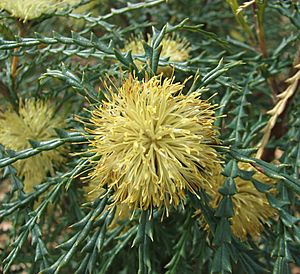Many-headed dryandra facts for kids
Quick facts for kids Many-headed dryandra |
|
|---|---|
 |
|
| Banksia polycephala in Cranbourne Botanic Gardens | |
| Scientific classification | |
| Genus: |
Banksia
|
| Species: |
polycephala
|
| Synonyms | |
|
|
The Many-headed Dryandra (Banksia polycephala) is a type of bushy shrub. It grows only in Western Australia. This plant has long, thin leaves with many small, triangular points. It also has small, creamy yellow flowers that grow in groups. After flowering, it produces egg-shaped seed pods.
Contents
What it Looks Like
The Many-headed Dryandra is a bushy shrub. It usually grows up to 4 m (13 ft) tall. This plant does not form a lignotuber, which is a woody swelling at the base of some plants that helps them regrow after a fire.
Leaves
Its leaves are long and thin. They are 50–200 mm (2.0–7.9 in) long and 3–6 mm (0.12–0.24 in) wide. The leaves are attached to the stem by a short stalk called a petiole, which is 1–2 mm (0.039–0.079 in) long. Each leaf has between ten and twenty-five sharp, triangular points on each side. The petiole might also have one or two small teeth.
Flowers and Fruit
The plant produces sixty to seventy creamy-yellow flowers. These flowers grow together in round groups, called heads. At the base of each flower head are small, lance-shaped leaves called involucral bracts, which are up to 7 mm (0.28 in) long.
Each individual flower has a perianth (the outer parts of the flower) that is 13–15 mm (0.51–0.59 in) long. The pistil, which is the part of the flower that receives pollen, is 16–19 mm (0.63–0.75 in) long.
The Many-headed Dryandra flowers from August to October. After flowering, it produces egg-shaped seed pods, called follicles. These pods are 7–9 mm (0.28–0.35 in) long. Each flower head usually forms only up to three of these seed pods.
How it Got its Name
This plant was first officially described in 1870 by a scientist named George Bentham. He named it Dryandra polycephala. He wrote about it in a book called Flora Australiensis, using samples collected by James Drummond.
The second part of its name, polycephala, comes from two ancient Greek words:
- polys (πολύς) means "many"
- kephalē (κεφαλή) means "head"
So, polycephala means "many-headed," which describes how its flowers grow in many groups.
In 2007, two other scientists, Austin Mast and Kevin Thiele, moved all the plants from the Dryandra group into the Banksia group. This is why the plant's name changed to Banksia polycephala.
Where it Lives
The Many-headed Dryandra only grows in a specific area of Western Australia. You can find it between the towns of New Norcia and Bindoon. It grows in woodlands, often alongside Eucalyptus wandoo trees.
Is it Endangered?
The Western Australian Government's Department of Parks and Wildlife has looked at the Many-headed Dryandra. They have classified it as "not threatened." This means it is not currently at risk of disappearing.

